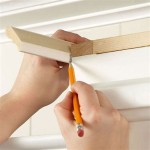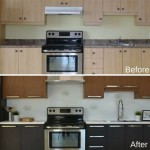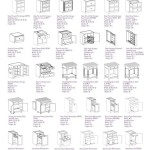How To Remove Cooking Oil Stains From Kitchen Cabinets
Kitchen cabinets, particularly those near the stove, frequently fall victim to cooking oil stains. These stains can accumulate over time, creating a sticky, unsightly residue that can be challenging to remove. Timely and effective cleaning practices are essential to maintaining the appearance and hygiene of kitchen cabinets. Ignoring these stains can lead to the buildup of hardened grease, making removal significantly more difficult and potentially damaging the cabinet finish.
The composition of cooking oil, typically comprising triglycerides, makes it hydrophobic, meaning it does not readily mix with water. This characteristic is why water alone is ineffective at removing oil stains. Instead, solvents and detergents are needed to emulsify the oil, breaking it down into smaller particles that can be washed away. The type of cabinet finish (e.g., wood, laminate, painted) also influences the cleaning method employed, as some finishes are more susceptible to damage from harsh chemicals or abrasive cleaners.
Before proceeding with any cleaning method, it is paramount to test the chosen solution in an inconspicuous area of the cabinet, such as the inside of a door or a lower corner. This test helps to ensure that the cleaning solution does not discolor, damage, or otherwise negatively impact the cabinet's finish. Allow the test area to dry completely before assessing the results. The results of this test will determine whether the solution is appropriate for cleaning the entire surface.
The frequency of cleaning kitchen cabinets is dependent on cooking habits. Homes where cooking is a daily activity will require more frequent cleaning than households where cooking occurs less often. Regular wiping down of cabinets with a damp cloth can prevent the accumulation of oil stains, reducing the need for more intensive cleaning measures. Establish a routine of cleaning splatters and spills immediately after they occur to prevent them from setting into stubborn stains.
Key Point: Preparing for Cleaning
Before commencing the cleaning process, proper preparation is crucial. Gather all necessary cleaning supplies, including appropriate cleaning solutions, microfiber cloths, a soft-bristled brush (optional), warm water, and protective gloves. Ensure the area around the cabinets is clear of obstructions. Cover countertops and flooring beneath the cabinets with drop cloths or towels to protect them from drips and splatters.
Ventilation is also important. Open windows or turn on the kitchen exhaust fan to ensure adequate airflow. This is particularly important when using cleaning solutions with strong odors or volatile organic compounds (VOCs). Adequate ventilation minimizes exposure to potentially harmful fumes and ensures a safer cleaning environment.
Inspect the cabinets closely to identify areas with heavy oil buildup. These areas may require pre-treatment before general cleaning. Photographic documentation can also be helpful to illustrate the effectiveness of the cleaning process, providing a before-and-after comparison.
Key Point: Effective Cleaning Solutions and Methods
Several cleaning solutions can be effective in removing cooking oil stains from kitchen cabinets. The choice of solution depends largely on the severity of the stain and the type of cabinet finish.
Dish Soap and Water: This is often the first line of defense for removing mild oil stains. Mix a small amount of dish soap with warm water. Dip a microfiber cloth into the solution, wring out excess water, and gently wipe the stained areas. Rinse the cloth frequently in clean water and repeat the process until the stain is removed. Finally, dry the cabinets with a clean, dry microfiber cloth.
Baking Soda Paste: Baking soda is a mild abrasive that can help lift stubborn oil stains. Create a paste by mixing baking soda with a small amount of water. Apply the paste to the stained area and allow it to sit for 5-10 minutes. Gently scrub the area with a soft-bristled brush or a microfiber cloth. Rinse thoroughly with warm water and dry with a clean cloth. Be cautious when using baking soda on delicate wood finishes, as it can scratch the surface if applied too aggressively.
Vinegar Solution: Vinegar is a natural degreaser that can dissolve oil and grease. Mix equal parts white vinegar and water in a spray bottle. Spray the solution onto the stained area and let it sit for a few minutes. Wipe the surface with a clean, damp cloth. For stubborn stains, increase the concentration of vinegar in the solution. Vinegar's acidic nature can potentially damage certain finishes, so testing in an inconspicuous area is crucial.
Commercial Degreasers: Numerous commercial degreasers are specifically formulated for removing grease and oil from kitchen surfaces. Always follow the manufacturer's instructions carefully when using these products. Ensure the product is compatible with the cabinet finish. Wear protective gloves and ensure adequate ventilation when using commercial degreasers.
Oil-Based Soap: Oil-based soaps, such as Murphy Oil Soap, are designed to clean wood without stripping its natural oils. Dilute the soap in water according to the manufacturer's instructions. Use a microfiber cloth to apply the solution to the cabinets, wiping in the direction of the wood grain. Rinse with a clean, damp cloth and dry thoroughly.
Steam Cleaning: Steam cleaners can effectively loosen and dissolve grease and oil without the need for harsh chemicals. Use a steam cleaner with a soft brush attachment and direct the steam onto the stained areas. Wipe away the loosened residue with a clean microfiber cloth.
When cleaning, avoid using abrasive scrub pads or steel wool, as these can scratch and damage the cabinet finish. Always use gentle scrubbing motions and avoid applying excessive pressure.
Key Point: Preventing Future Oil Stains
Preventing future oil stains is often easier than removing existing ones. Several strategies can be implemented to minimize oil splatters and maintain clean cabinets.
Regular Cleaning: Establish a routine of wiping down kitchen cabinets regularly, ideally after each cooking session. Use a damp microfiber cloth to remove any splatters or spills before they have a chance to dry and harden.
Using a Backsplash: Install a backsplash behind the stove to protect the wall and cabinets from oil splatters. Backsplashes made of tile, glass, or stainless steel are easy to clean and maintain.
Proper Ventilation: Ensure adequate ventilation when cooking to remove airborne grease and oil particles. Use the kitchen exhaust fan or open windows to improve airflow.
Using Splatter Screens: When frying or sautéing, use a splatter screen to prevent oil from splattering onto surrounding surfaces. These screens are inexpensive and easy to clean.
Immediate Spill Cleanup: Clean up spills immediately after they occur to prevent them from setting into stubborn stains. The longer a spill sits, the more difficult it becomes to remove.
Cabinet Liners: Consider using cabinet liners in drawers and shelves to protect them from spills and stains. These liners can be easily removed and cleaned or replaced as needed.
Protective Coatings: Applying a protective coating to kitchen cabinets can help to repel oil and grease. Consult with a professional to determine the best coating for the specific cabinet finish.
By implementing these preventative measures, it is possible to significantly reduce the incidence of cooking oil stains on kitchen cabinets, maintaining a clean and attractive kitchen environment.
Addressing cooking oil stains on kitchen cabinets requires a combination of appropriate cleaning solutions, effective cleaning methods, and preventative measures. By understanding the nature of oil stains and the characteristics of different cabinet finishes, homeowners can effectively remove existing stains and prevent future buildup, preserving the appearance and longevity of their kitchen cabinets.

How To Clean Grimy Kitchen Cabinets With 2 Ingredients

How To Clean Sticky Grease Off Kitchen Cabinets Ovenclean

Clean Kitchen Cabinets Off With These Tips And Hints

How To Remove Grease From Kitchen Cabinets 3 Methods Bob Vila

Get Grease Off Kitchen Cabinets Easy And Naturally

How To Clean Kitchen Cabinets Everyday Skate

I Have A Complete Mess Of Cooking Oil Inside Cabinet Help Hometalk

Best Ways To Clean Grease Stains Off Kitchen Cabinets

How To Clean The Grease And Oil Of Kitchen Cabinet Remover
:max_bytes(150000):strip_icc()/ways-to-clean-wood-kitchen-cabinets-3017289-00-fb8e5ae9eb004ec6b968f9d53e74cd1e.jpg?strip=all)
Tips For Cleaning Food Grease From Wood Cabinets
Related Posts








